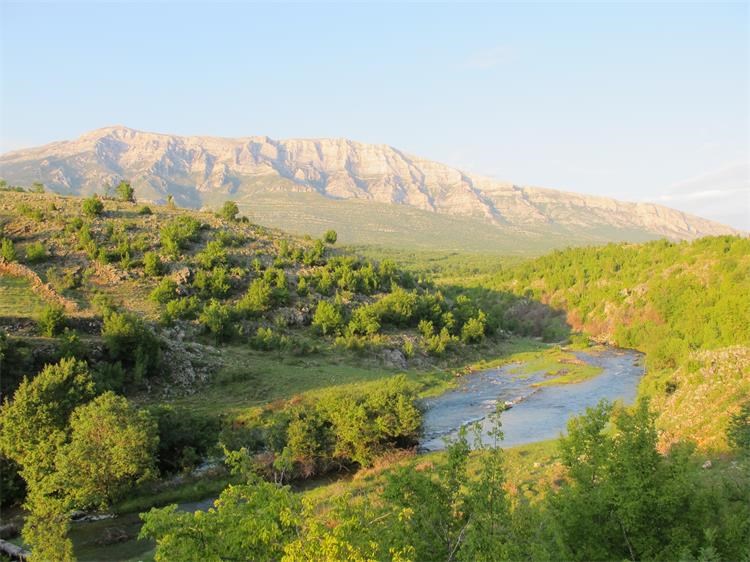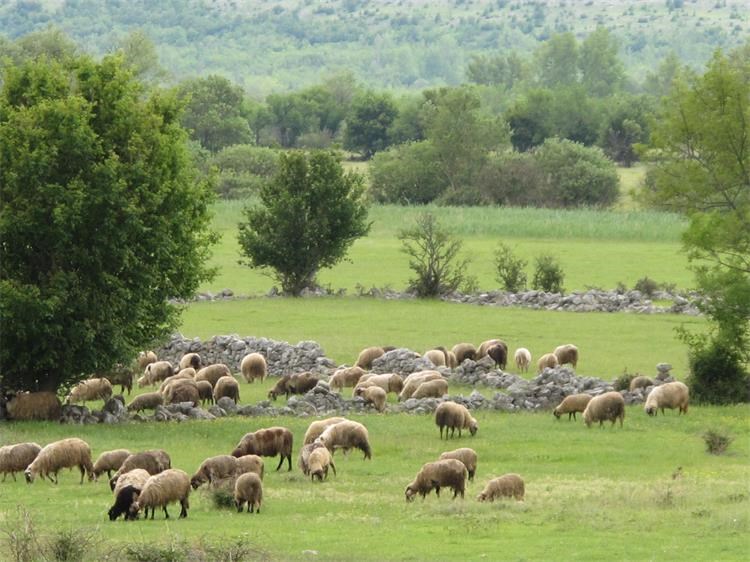Croatia's Environmental Affairs in 2021: New Nature Park, Progress in Waste Sorting
ZAGREB, Jan 2021 - Croatia's environmental affairs in 2021 were marked by the declaration of Dinara as the 12th nature park and the awarding of the status of UNESCO designated site to the Mura-Drava-Danube Biosphere Reserve.
On 5 February, the Croatian parliament unanimously adopted a law declaring Mount Dinara the 12th nature park in Croatia. The nature park encompasses Croatia's section of Mount Dinara as well as Mt Troglav and Mt Kamešnica, the upper course of the Cetina River and the Hrvatačko, Paško, and Vrličko karst fields. It extends over two counties - Split-Dalmatia and Šibenik-Knin -- measuring almost 63,000 hectares in area. Dinara is part of the Dinaric Alps, also commonly known as the Dinarides, a mountain range in Southern and Southeastern Europe.
On 15 September, UNESCO's international coordinating council designated the transboundary biosphere reserve which stretches along the Drava, Mura, and Danube Rivers as the first biosphere reserve extending through five countries: Austria, Slovenia, Croatia, Hungary, and Serbia. The Mura, Drava, and Danube Rivers form a 700-kilometer-long green belt, also known as the Amazon of Europe, connecting almost a million hectares of unique terrain with significant natural and cultural heritage, becoming the first five-country biosphere reserve in the world.
Legislative activities in environment protection
In July, the Croatian parliament passed a law banning the use of plastic carrier bags that are between 15 and 50 microns thick as of 1 January 2022, while other types of plastic bags will be phased out in the coming period.
A project aimed at better management of plastic waste has begun, and the first comprehensive national statistical survey on food waste was conducted.
The Ministry of Economy and Sustainable Development said that a strong positive trend of waste separation, collection, and recycling continued.
The waste sorting rate in 2020 was 41%, rising by 15 percentage points since 2016. Of the total municipal waste, 56% was landfilled and 34% recovered, which is an increase of 13 percentage points compared with 2016.
Prelog among best towns in Europe in sustainable waste management, Šibenik builds Bikarac waste management plant
In mid-December, the Zero Waste Europe network published new best sustainable waste management practices in Europe, including those in the northern Croatian town of Prelog and 11 neighboring municipalities.
Prelog, the first Croatian town to adopt a zero-waste strategy, and 11 neighboring municipalities (Belica, Donja Dubrava, Donji Vidovec, Sveta Marija, Goričan, Donji Kraljevec, Kotoriba, Dekanovec, Domašinec, Martijanec, Podturen), improved their result in total waste sorting from 57.25% in 2019 to 65.23% in 2020.
On 21 December, the City of Šibenik's waste management center began a test run of the HRK 245 million Bikarac waste management plant, with Economy and Sustainable Development Minister Tomislav Ćorić praising Šibenik for setting an example to other cities on how to resolve the issue of waste management. Currently, about 73,000 tonnes of waste is delivered to Bikarac with more than 40,000 tonnes of municipal waste. The capacity of the mechanical-biological plant is to process about 70,000 tonnes of waste a year.
In June, Parliament adopted the national low carbon development strategy until 2030 with an outlook until 2050.
For more, check out our lifestyle section.
Croatia Declares Mount Dinara 12th Croatian Nature Park!
February 5, 2021 – Croatia gets one more protected area as Mount Dinara becomes the 12th Croatian nature park.
Today, the Croatian Parliament proclaimed the Mount Dinara Nature Park. The Park will encompass the area of the Dinara massif (Dinara, Troglav, and Kamešnica), the Cetina River's upper course, and the Hrvatačko, Paško, and Vrličko karst fields. The highest peak of Croatia – Sinjal (1831 m), is located in the Park, too. These mountains are part of the Dinaric Alps, also commonly known as Dinarides, a mountain range in Southern and Southeastern Europe.
As the Minister of Economy and Sustainable Development Tomislav Ćorić said, the Mount Dinara Nature Park proclamation is an important moment for nature protection in Croatia, reports the Ministry.
"Mount Dinara Nature Park has become the 12th nature park in Croatia. Together with eight national parks, we have completed a set of 20 protected areas in the categories of nature and national parks," said the Minister.
Source: Ministry of Economy and Sustainable Development
With an area of 63,052 ha, Mount Dinara Nature Park stretches through Šibenik-Knin and Split-Dalmatia counties. It is thus the second-largest nature park in Croatia, after Velebit Nature Park.
With the proclamation of Mount Dinara Nature Park, the share of protected areas in Croatia's land area, together with the area of the ecological network Natura 2000, makes 39 percent of Croatia's land area protected. There are 11 areas of the Natura 2000 ecological network in the Park area – two conservation areas important for birds and nine conservation areas important for species and habitat types.
The Park area is rich in other values derived from the centuries-old tradition of human use of space – semi-natural habitats, indigenous breeds and varieties, and rich cultural and historical heritage. The Dinaric karst is a phenomenon recognized at the international level that covers a much wider area, and it was named after the Dinara as a type locality.
Source: Ministry of Economy and Sustainable Development
Over 1000 plant species live here, a fifth of the total Croatian flora, and 75 of them are national endemics. Also, over 20 endemic animal species live in this area, and due to the untouched vast complexes of forests and grasslands, it is essential for our large carnivores – wolves, bears, lynxes. High Dinaric grasslands are the most important locality in Croatia for the yellow mountain viper (Vipera ursinii macrops), an endemic Dinarides snake species.
The protection of this area will have positive effects on nature conservation, but also the population and the economy of the wider region. The revitalization of extensive livestock is expected, as well as other traditional activities and new opportunities for sustainable use of space.
Source: Ministry of Economy and Sustainable Development
To read more news from Croatia, follow TCN's dedicated page.
Dinara Nature Park: Croatia to Get Twelfth Incredible Nature Park
As Poslovni Dnevnik writes on the 22nd of May, 2020, a public presentation as part of the public insight into the Law on the Proclamation of the Dinara Nature Park was held recently in Knin.
The aforementioned Act will protect the Dinara massif (Dinara, Troglav and Kamešnica), the source part and the upper course of the river Cetina and the karst fields (Hrvatačko, Paško and Vrličko) along the Cetina river in the category of a nature park.
The event was attended by the Minister of Environmental Protection and Energy, Dr. Sc. Tomislav Ćorić, the Prefect of Šibenik-Knin County, Goran Pauk, the Prefect of Split-Dalmatia County Blaženko Boban, the Mayor of Knin dr. Sc. Marko Jelić and numerous citizens, representatives of non-governmental organisations and other interested parties.
Tomislav Ćorić pointed out that this is a special week for nature protection in Croatia. On May the 20th, 2020, the European Commission published a new Biodiversity Strategy for the period up until the year 2030, recently we marked Natura 2000 Day and then International Biodiversity Day and Nature Protection Day in Croatia, and this coming Sunday marks European Parks Week.
"The Dinara Nature Park will be the 12th nature park in the Republic of Croatia and together with eight other national parks, we'll complete one set of 20 such protected areas. With the proclamation of the Dinara as a nature park, the share of protected areas on Croatian land will increase from 12 percent to 13 percent, and under the European ecological Natura 2000 network, there will be an increase from 36.7 percent to 39 percent of the European Union's territory. This clearly shows what these 63,000 hectares of newly protected area will mean for the total capacity of protected areas in Croatia and, ultimately, what it will mean for the future of biodiversity in Croatia,'' said Minister Ćorić.
He emphasised that this is the direction in which the whole of Europe and the world should head in, and that is the direction of nature protection, biodiversity conservation and environmental protection for those who will come long after we have died.
"Of the 63,000 hectares of the future Dinara Nature Park, almost two thirds of the area is located in Split-Dalmatia County," said Split-Dalmatia County Prefect Blaženko Boban, adding that this is an area bordering Bosnia and Herzegovina and expressed hope that that part of the Dinara area on the territory of Bosnia and Herzegovina will also be protected.
Šibenik-Knin County Prefect Goran Pauk said that the proclamation of the Dinara Nature Park "will open this beautiful area up as a potential for the development of the entire area in a way that doesn't disturb the original natural beauty it boasts, and at the same time make the Dinara more accessible to both locals and visitors,''
"I hope that the first session of Parliament will promulgate this law. We'll have a nature park and we'll protect what's most important to us. The Krka and Cetina rivers have their springs in the future Dinara Nature Park and without them there would be no life for us either,'' said the Mayor of Knin, Marko Jelić.
The adoption of the proposed Law on the Proclamation of the Dinara Nature Park would create all of the legal preconditions for the establishment of a public institution, the adoption of a spatial plan for special features and the Dinara Nature Park management plan, which would further regulate the protection, improvement and general use and management of this protected area and its abundant nature.
The future Dinara Nature Park envisages the protection of an area of 63,052 hectares in both Šibenik-Knin and Split-Dalmatia counties, which is the largest area to be called a nature park after Velebit (200,000 hectares).
Otherwise, the overall Dinara area is extremely rich in endemic and endangered species. It is home to over 1000 plant species (one fifth of the total Croatian flora), of which 75 are endemic. Over 20 endemic species of animals are known, including one very special little mammal - the Dinaric vole.
The highest peak in the Republic of Croatia, Sinjal, which is 1831 metres tall, is also found there.
Make sure to follow our lifestyle page for more.





